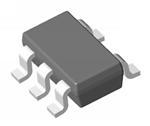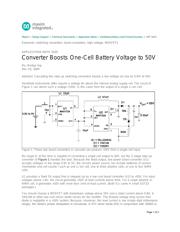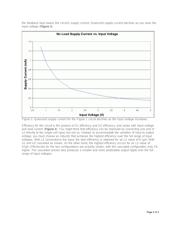下载

Maxim > Design Support > Technical Documents > Application Notes > Oscillators/Delay Lines/Timers/Counters > APP 3425
Keywords: switching converters, boost converters, high voltage, MOSFETs
APPLICATION NOTE 3425
Converter Boosts One-Cell Battery Voltage to 50V
By: Budge Ing
Dec 23, 2004
Abstract: Cascading two step-up switching converters boosts a low voltage (as low as 0.9V) to 50V.
Handheld instruments often require a voltage far above the internal analog supply rail. The circuit of
Figure 1 can derive such a voltage (+50V, in this case) from the output of a single Li-ion cell.
Figure 1. These two boost converters in cascade can produce +50V from a single-cell input.
No single IC at this time is capable of converting a single-cell output to 50V, but the 2-stage step-up
converter of Figure 1 handles the task. Because the fixed-output, low-power boost converter (U1)
accepts voltages in the range 0.9V to 5V, the circuit’s power source can include batteries of various
chemistries and cell counts—such as one Li-ion cell, one to three alkaline cells, or one to four NiMH
cells.
U1 provides a fixed 5V output that is stepped up by a low-cost boost controller (U2) to +50V. For input
voltages above 1.8V, the circuit generates +50V at load currents above 6mA. For a single alkaline or
NiMH cell, it generates +50V with more than 1mA of load current. (Both ICs come in small SOT23
packages.)
You should choose a MOSFET with breakdown voltage above 55V and a rated current above 0.8A. A
1N4148 or other low-cost silicon diode serves for the rectifier. The forward voltage drop across that
diode is negligible in a +50V system. Because, moreover, the load current is low (single-digit milliampere
range), the diode’s power dissipation is minuscule. A 47V zener diode (D2) in conjunction with 300kΩ in
Page 1 of 3





